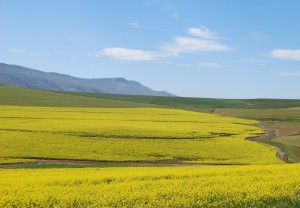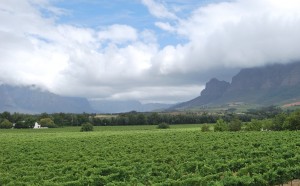CHAPTER < FOUR CONTD...
 For the first time in the history of the planet there is now “a discernible human influence on global climate” as documented in the World Scientists’ Call for Action, and the ramifications of this rapid climatic warm-up are extremely serious, especially if seen in the context of the time frame within which previous warm-ups have occurred.
For the first time in the history of the planet there is now “a discernible human influence on global climate” as documented in the World Scientists’ Call for Action, and the ramifications of this rapid climatic warm-up are extremely serious, especially if seen in the context of the time frame within which previous warm-ups have occurred.
Up to the present time it seems that the majority of natural climatic shifts have occurred relatively slowly. Since the last Ice Age ended approximately 10 000 years ago, the planet has warmed by a global mean average of about five degrees centigrade to present-day temperatures. However, by about 2030, if carbon dioxide levels in the atmosphere continue to rise, which would double present concentrations, the global climate could have warmed up by an additional four to five degrees centigrade or an equivalent of up to one degree centigrade or more per decade.
Such a significant change, occurring in tens of years and not thousands of years as has predominantly happened before, could send the world’s climate into a state of dramatic disequilibrium and with it shock waves throughout every living system on the planet.
Climatic Variability and Food Production
 Every species of animal and plant on Earth lives within a characteristic niche habitat and a range of climatic conditions that determines its ability to survive. Unlike our own species, which is able to adjust to almost every environmental and climatic variation through cultural and technological adaptation, for many other animal and plant species this range is quite narrow and big changes occurring rapidly, spell disaster.
Every species of animal and plant on Earth lives within a characteristic niche habitat and a range of climatic conditions that determines its ability to survive. Unlike our own species, which is able to adjust to almost every environmental and climatic variation through cultural and technological adaptation, for many other animal and plant species this range is quite narrow and big changes occurring rapidly, spell disaster.
With changes in air and ocean currents, many anomalies have already occurred and are continuing to occur all over the world: anomalies such as altered habitats, persistent drought, an increase in severity of cold winters and hot summers, floods, forest fires, blizzards and hurricanes, all products of a weather machine being pushed beyond stability. Globally, this could result in the beginning of die-outs on a massive scale.
From a human perspective, as climatic zones shifted in response to changing weather patterns, bringing more rain to some areas of the globe and less rain to others, farm belts would change location, with agriculture thriving in some parts of the world whilst declining in others.
 Some important food producing regions would be lost whilst others would be gained. This would mean that global food supplies would be even more unevenly distributed than at present, which could have serious social, economic and political implications as the balance of world power shifted in relation to food surpluses and shortages.
Some important food producing regions would be lost whilst others would be gained. This would mean that global food supplies would be even more unevenly distributed than at present, which could have serious social, economic and political implications as the balance of world power shifted in relation to food surpluses and shortages.
An increase of carbon dioxide in the atmosphere with a resultant increase in global temperature would also mean that some crops passed through their stages of growth more quickly than normal. Tests have shown that under these conditions, yields of some strains were smaller, as were individual grain sizes. And another response to an increased carbon dioxide atmospheric concentration would be the growth of larger leaves in some plant species. This would mean far fewer plants per acreage with smaller crop yield. Higher temperatures with poor chill accumulation would also result in crop losses of certain important crops such as commercial deciduous fruit cultivars which have a medium to high chilling requirement.
Yet another factor that would affect global food production is the resistance of insect and microbe populations to pesticides as global warming contributed to their increased prevalence and virulence. With a decrease in plant diversity, the competition and predation among insects also declines. This could result in valuable food-producing croplands being overrun by destructive insect pests. Pesticides used as a panacea to solve the problem would only have a short-term benefit, as in the longer term, useful insect species would be killed off whilst “insect baddies” became resistant to the pesticide chemicals.
 With the equation of a decline in plant diversity equalling an increase in the prevalence of destructive insects, a vicious cycle would set in on the croplands of the globe. This would force farmers and farm workers to use an ever-wider assortment of pesticides and insecticides in their armamentarium in the war against cropland pests. These are serious problems as the resultant effect of all these critical factors could manifest in widespread hunger, cross-border infiltration, migrations of increased numbers of people and bitter conflict as people tried to expropriate food supplies by force.
With the equation of a decline in plant diversity equalling an increase in the prevalence of destructive insects, a vicious cycle would set in on the croplands of the globe. This would force farmers and farm workers to use an ever-wider assortment of pesticides and insecticides in their armamentarium in the war against cropland pests. These are serious problems as the resultant effect of all these critical factors could manifest in widespread hunger, cross-border infiltration, migrations of increased numbers of people and bitter conflict as people tried to expropriate food supplies by force.
Conscious or unconscious tampering with the global weather machine is an extremely dangerous business, as we have yet to learn the parameters that demarcate the limits for human existence. In the meantime we have been playing Russian roulette with our food supply, which is a potentially disastrous scenario for all of humankind. For a species that has intelligence as a defining characteristic, this is an almost unbelievable state of affairs. Has the situation crept up on us unawares like a thief in the night, potentially robbing us of a secure future? It appears not. The signs have been there all along, heeded by some but ignored by many. If we are to reverse this negative trend there is much work to be done by us all…